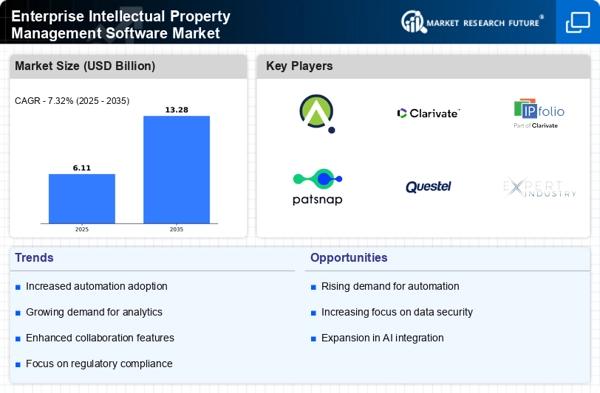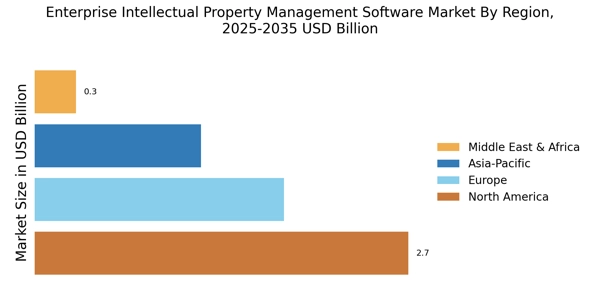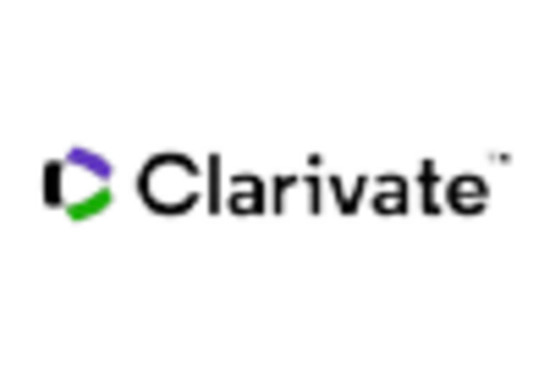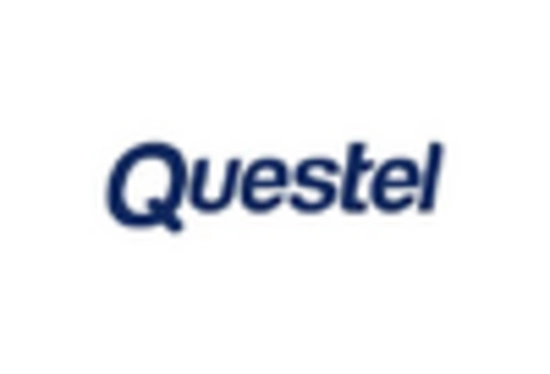The Enterprise Intellectual Property Management Software Market is currently characterized by a dynamic competitive landscape, driven by the increasing need for organizations to protect their intellectual assets in an increasingly digital world. Key players such as Anaqua (US), CPA Global (GB), and Industry expert's (GB) are at the forefront, each adopting distinct strategies to enhance their market positioning. Anaqua (US) focuses on innovation through the integration of advanced analytics and AI capabilities into its software solutions, thereby enabling clients to make data-driven decisions regarding their intellectual property portfolios. Meanwhile, CPA Global (GB) emphasizes strategic partnerships and acquisitions to expand its service offerings and geographical reach, which appears to enhance its competitive edge. Industry expert's (GB), on the other hand, is concentrating on digital transformation initiatives, aiming to streamline processes and improve user experience, which collectively shapes a competitive environment that is increasingly reliant on technological advancements.
The business tactics employed by these companies reflect a market structure that is moderately fragmented, with a mix of established players and emerging startups. Localizing services and optimizing supply chains are common strategies that enhance operational efficiency and customer satisfaction. The collective influence of these key players is significant, as they not only set industry standards but also drive innovation that influences the broader market dynamics.
In August 2025, Anaqua (US) announced a strategic partnership with a leading AI firm to enhance its software capabilities, particularly in predictive analytics for patent management. This move is likely to position Anaqua as a leader in providing cutting-edge solutions that anticipate market trends, thereby offering clients a competitive advantage in managing their intellectual property. The integration of AI into their offerings may also attract a broader client base seeking advanced technological solutions.
In September 2025, CPA Global (GB) completed the acquisition of a regional IP management firm, which is expected to bolster its presence in the Asia-Pacific market. This acquisition not only expands CPA Global's geographical footprint but also enhances its service portfolio, allowing it to cater to a diverse range of clients. Such strategic moves indicate a clear intent to capitalize on emerging markets, which could yield substantial growth opportunities in the coming years.
In July 2025, Industry expert's (GB) launched a new suite of tools designed to facilitate collaboration among IP professionals, which appears to be a response to the growing demand for integrated solutions in the IP management space. This initiative underscores Industry expert's's commitment to fostering innovation and collaboration, potentially setting a new standard for how IP management software is utilized across industries.
As of October 2025, the competitive trends within the Enterprise Intellectual Property Management Software Market are increasingly defined by digitalization, sustainability, and the integration of AI technologies. Strategic alliances are becoming more prevalent, as companies recognize the value of collaboration in enhancing their service offerings and market reach. Looking ahead, it is anticipated that competitive differentiation will increasingly pivot from traditional price-based competition to a focus on innovation, technological advancements, and the reliability of supply chains. This shift suggests that companies that prioritize these elements will likely emerge as leaders in the evolving landscape.


















Leave a Comment